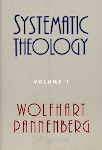2 years ago
Monday, 21 April 2008
Theology of Art, Part III
Theology of Art, Part I
Hands and Brains (or Lack of)
Hands and Brains (or Lack of) (continued)
Theology of Art, Part II
The Body - Neither Puritanism nor Pornography
The Body - Neither Puritanism nor Pornography (continued)
Theology of Art, Part III
Nakedness and imago Dei
Nakedness and imago Dei (continued)
- - - - - - - - - - - - - - - - - - - -
Nakedness and Imago Dei
John Paul II (1920-2005), the first non-Italian pope for some 450 years, began the Sistine Chapel's renovations and ordered the removal of all loincloths that his predecessor popes had commissioned to cover Michelangelo's nudes, supposedly, in the name of Christian purity. John Paul II had the removed on the same grounds: Christian purity. Why?
In the opening speech of the completed work, John Paul II described the chapel as the "sanctuary of the theology of the body". What did he mean by that?
Earlier (Part I), we contemplated the role of both intelligence (head) and action (hands) in authentic human life. Later (Part II), we considered two other inseparable sides of the same coin which is Man: the intimate connection between body and soul in Christian anthropology. In this third and final part, Christian anthropology will remain the theme, but we will focus on theological anthropology.
"Theology of the body" - what is it?
Theology means the study of God and our relationship with him. Theology of the body, consequently, means the study of God and our relationship with him from the body's - our body's - perspective. What does the body say about God? Or inversely: how does the imago Dei ("image of God", see Gen. 1:27) reflect in our bodies?
There must be reflections in the body too because, as noted earlier, we are made in the image of God in unity of body and soul.
Let's return to John Paul II. During 1979-1984, except for the weeks following his assassination attempt, he held weekly Bible studies on love and sexuality. These talk were later published as the Theology of the Body (TOB). His biographer, George Weigel, calls TOB a "theological time bomb, set to go off with dramatic consequences sometime in the third millenium." For those who find TOB too difficult, see Christopher West's TOB Explained (2003) or TOB for Beginners (2004).
In the years to come, it will be instrumental in saving marriages, severing addictions (especially of the sexual kind), and saving souls - which is, of course, the ultimate point of all faithful theology. Its biblical and theological fine points cannot be discussed here. But what does the theology of the body have to do with art?
(continued...)
Subscribe to:
Post Comments (Atom)







No comments:
Post a Comment